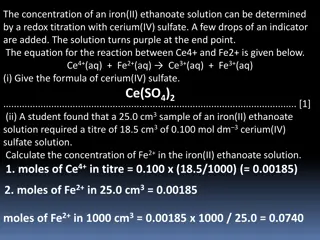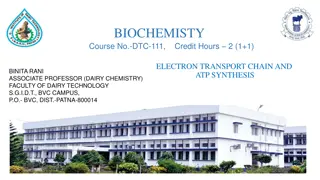Understanding Electrochemistry: A Comprehensive Overview
Dive into the world of electrochemistry with this detailed review covering topics such as oxidation, reduction, half-reactions, and the significance of oxidation numbers in balancing redox equations. Explore key concepts like OIL RIG (Oxidation Is Loss, Reduction Is Gain) and learn how to apply electronegativity to determine charges in compounds. Enhance your understanding of the main force behind electrochemistry and the importance of electron transfer in reactions.
Download Presentation

Please find below an Image/Link to download the presentation.
The content on the website is provided AS IS for your information and personal use only. It may not be sold, licensed, or shared on other websites without obtaining consent from the author. Download presentation by click this link. If you encounter any issues during the download, it is possible that the publisher has removed the file from their server.
E N D
Presentation Transcript
Electrochemistry Intro Review Week of 11/19/18 Geoff Geberth
REDOX Chemistry The main force behind electrochemistry Oxidation Loss of electrons from a species (gets more positively charged) Reduction Gain of electrons from a species (gets less positively/more negatively charged) OIL RIG Oxidation Is Loss; Reduction Is Gain BOTH processes happen in a reaction. You will have both an oxidation and a reduction The electrons must go somewhere This is how batteries work
Oxidation numbers 0 for all species in an elemental state For a monatomic ion, Ox # = charge Sum of all Ox # s must equal the net charge of the species In compounds, hydrogen is +1 unless bonded to a metal, in which case it is -1 (such as LiH) The most electronegative element is assigned its charge as an ion (ex: in MgBr2, Br = 1- and therefore Mg = 2+ Unless bonded to another oxygen in a peroxide, oxygen is -2. It is -1 in a peroxide (H2O2)
Remember your electronegativity Utilized from gchem
Lets Practice! 3 ??4 O = -2; P = +5 ??4 O = -2; S = +6 ????3 Cl = -1; Fe = +3 ??2??4 3 Al = +3 (see sulfate above) ??2???6 Na = +1; F = -1; Si = +4 2
Why do we care? Use oxidation numbers to determine what gets oxidized or reduced in a reaction Ex: 2?? ? + 3?2(?) 2??2?3(?) Oxygen takes a -2, so we have -6, therefore Iron becomes +3 to balance. Iron is oxidized, oxygen (going from 0 to -2) is reduced What are the two reactions we re dealing with (ignoring stoichiometry)? ?? ??3++ 3? ?2+ 2? 2?2 These are called Half-reactions. They are important for balancing Redox equations
A bit of important nomenclature The species that undergoes reduction is the oxidizing agent and by nature causes oxidation The species that undergoes oxidation is the reducing agent and by nature causes reduction In the previous reaction with iron and oxygen, what are the oxidizing a reducing agents? Oxidizing agent = Oxygen (is reduced) Reducing agent = Iron (is oxidized)
Balancing Redox reactions (the half-reaction method)(acidic conditions) Identify your half reactions For each half reaction, balance all elements EXCEPT hydrogen and oxygen Balance the oxygens by adding H2O Balance the hydrogens by adding H+ Balance the total charge using electrons (e-) Match the electron count for the two half-reactions by multiplying stoichiometric coefficients of the half-reactions Combine the two reactions to make the overall, cancelling any species on both sides Check your work to make sure you have the same components on both sides
Lets practice In the video game Rainbow 6 Siege, fictional operator Dominic Brunsmeier (codename Bandit) utilizes lead acid batteries in order to electrify surfaces. (RXN = ?? ? + ???2(?) ????4(?) ??(0) ? ??(+2)???(?) 2 ?????(?) ??(+4)??? ??(+2)??? 2 ?? ????? ????? + ??? ??++ ????? + ??? 2? + ??++ ????? + ??? Combine your balanced half reactions! ?? ? + ??? ????? + ??? 2 ?? ?????+ ???? 2 ?? ?????+ ???? 2 ?? ?????+ ???? 2 ?????? + ?? ?? ? + ??? 2 + ?? + ??++ ????? + ??? ?? ? + ??+(??) + ????? + 2??? ?? ? + +????? + ?????4?? ?????+ ???? + ?????? 2 ?? ?????+ ???? + ?????? + ?? 2 ?? ?????+ ???? + ?????? ?? ? + ??? Far more importantly, lead acid batteries are what you find in standard (non-hybrid or electric) automobiles!
Basic conditions First, balance under acidic conditions Add the same number of OH- ions to the side of the eqn with H+ so that the acid is neutralized into water Add the same number of OH- to the other side of the reaction On the side with both H+ and OH-, cross them out and replace with water (This is the switch from acidic to basic conditions) Cancel any waters that appear on both sides of the equation Double check the balance
Practice in base Initial reaction: ???4 ??4 Balanced in acid (Do this yourself as an exercise): 2?+?? + 2???4 2???2? + 3??4 2?? + 2?+?? + 2???4 2???2? + 3??4 2?2? ? + 2???4 2???2? + 3??4 ?2? ? + 2???4 3??4 ?? ???2? + ?? + ??3 (??) ?? ?2? ? + ?? + 3??3 (??) ?? ?2? ? + ?? + 3??3 (??) ?? + 3??3 ?? + 2?? ?? + 3??3 ?? ?2? ? + ?? 2???2? + ?? + 2??























